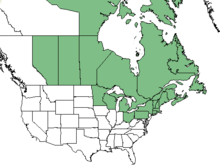Lonicera villosa
| Lonicera villosa | |
|---|---|

| |
| Scientific classification | |
| Kingdom: | Plantae |
| Clade: | Tracheophytes |
| Clade: | Angiosperms |
| Clade: | Eudicots |
| Clade: | Asterids |
| Order: | Dipsacales |
| Family: | Caprifoliaceae |
| Genus: | Lonicera |
| Species: | L. villosa
|
| Binomial name | |
| Lonicera villosa (Michx.) Schult.
| |

| |
| Lonicera villosa range | |
Lonicera villosa, also known as mountain fly honeysuckle, is a species of honeysuckle native to North America.[1]
Growth[]
Lonicera villosa is a small bush, ranging from 1 to 5 feet in height.[2] The elongated white flowers grow in clusters, while its blue berries grow in pairs.
Distribution[]
Lonicera villosa occurs across the Northern and Northeastern United States, as well as Central, Eastern, and Northern Canada.[3]
Uses[]
The berries of Lonicera villosa are edible and sometimes mistaken for blueberries.
References[]
- ^ "Lonicera villosa". Integrated Taxonomic Information System. Retrieved 6 May 2018.
- ^ "Lonicera villosa". Plants for a Future. Retrieved 7 May 2018.
- ^ USDA, NRCS (n.d.). "Lonicera villosa". The PLANTS Database (plants.usda.gov). Greensboro, North Carolina: National Plant Data Team. Retrieved 6 May 2018.
Categories:
- NatureServe secure species
- Lonicera
